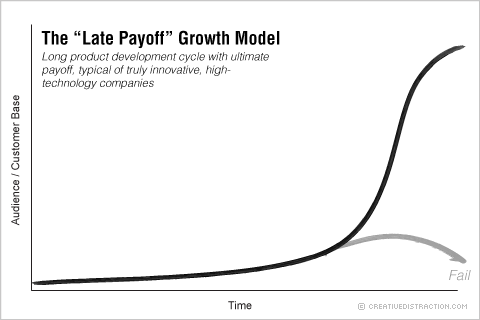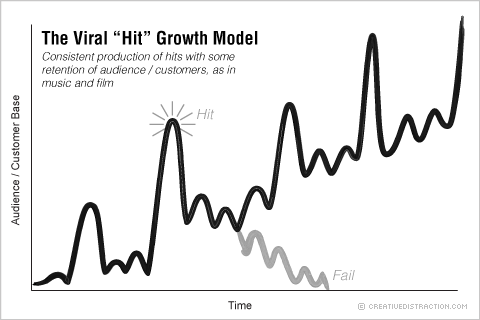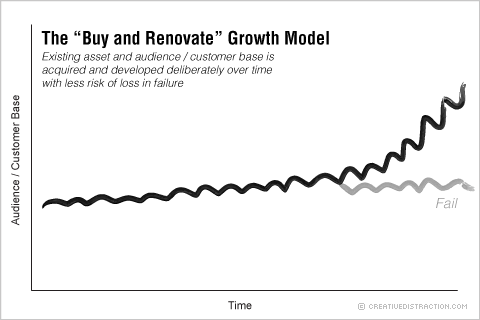I recently joined Huffington Post co-founder Ken Lerer for his series of sessions at Columbia Graduate School of Journalism designed to instigate entrepreneurs among the current class of journalists who, mind you, have scant job prospects in traditional media. For one of the sessions, Lerer invited viral marketing whiz and founder of BuzzFeed Jonah Peretti to discuss growth models for Web start-ups.
Lerer and Peretti, both successful media entrepreneurs, agreed that there are two possible models: (1) the slow, “late payoff” model of quality product development and perserverence, often seen in truly innovative, high-technology companies; and (2) the spiky, incremental growth typical of content companies who score occasional, viral “hits” with some retention of audience each time. (The music and film businesses, for example, are classic hit businesses).


Unfortunately for the J-School students in that classroom, among them perhaps some of the brightest future writers and journalists on the planet, both the “late payoff” model and the “hit” model confront the writer cum entrepreneur with the prospect of near-certain failure. In the case of the “late payoff” model, the long product development cycle must be financed, its many risks borne, while the chance of breaking through the white noise of newly launched sites and apps hovers just above zero. Viral scores or “hits” are more easily engineered (though far from guaranteed, unless you hire Peretti!), but viral traffic in itself does not a business make — it must be sustained and monetized and made a viable franchise. No easy feat.
A third, less-sexy and less-talked-about model for building a Web-based content company — and one not discussed by Lerer and Peretti — is the “buy and renovate,” or “flip,” model. Like its real estate analog, “flipping” Web properties consists of buying an under-performing website in a profitable niche, upgrading it enough to give it the highest possible perceived value, and then re-selling it. The practice is mature enough now that it has a vibrant marketplace over at SitePoint, and website flipping has attracted its share of self-declared gurus selling their own proprietary “flipping systems” for “huge profits” with “no technical know-how required.”
But flipping doesn’t have to be sleazy or purely profit-driven. While many flippers are grossly (and openly) motivated by potential profits, their techniques for evaluating, buying and re-building websites can be copied by writers and content experts looking to start projects with diverse goals. Most writers and content experts want their work to generate income, be valuable to others, build their reputation in a given subject area and allow them to focus on developing their craft or expertise. In contrast to the “late payoff” and “hit” models, the “buy and renovate” model may suit them best.

A “buy and renovate” project can take any number of forms, but its key advantage over the other models is that it starts with an asset: an existing site with age, content, referrers, search rank, membership rolls, what have you. While there is a price to pay for such an asset, which may mean the writer-entrepreneur must raise investment dollars or strike an equity deal with the seller, the risks and time-to-market of the project can be slashed while its chances of success are dramatically improved.
While a certain business calculus is required, building a valuable website doesn’t strictly mean selling out. A steady-earning site avails its owner of the security, time and resources needed to do something more ambitious, to forge one’s own vision using its raw materials, to create.
Imagine, for example, discovering in your field of expertise or interest a topical website with 100 pages of content last updated in 2004. By age alone the site gets a decent volume of organic traffic from search engines and referrers, but it is an ugly, untended and un-monetized site (i.e. there are no ads, subscriptions, or other pay services associated with it). A website flipper would see a good candidate for a flip: an under-performing, niche website that can be transformed into a steady earner by optimizing code and search performance, buying some syndicated content, freshening up the design and maybe adding a couple of blocks of Google AdSense or affiliate links.
Writers are often troubled by the value system implicit in this hypothetical deal, the driver of which is not the true quality of the content but its performance in search algorithms through optimizations like keyword richness, semantic markup, etc. Some recoil from the necessity of serving both human and monetary interests. A site devoted to the latest fertility/infertility treatments, for example, is likely to be much more valuable than a comparable one devoted to the history of fertility practices. Though both have tremendous human interest, advertisers like pharmaceutical companies and fertility clinics are likely to advertise only with the former, paying a premium for its targeted audience.
Still, while a certain business calculus is required, building a valuable website doesn’t strictly mean selling out. A steady-earning site avails its owner of the security, time and resources needed to do something more ambitious, to forge one’s own vision using its raw materials, to create. Given how much content on the Web has fallen into disrepair, buying and renovating lesser sites can be as much a public good as anything.
Perhaps, then, it’s more practical for the next wave of writer-entrepreneurs to learn how to re-build these darkened corners of the Web than how to create the next HuffPo or BuzzFeed. I’m not sure that there’s “no technical know-how required,” but this exercise is really to think differently about the audience for one’s work, its value, its medium and the possibilities for upside that exist outside of creating the next big thing.
